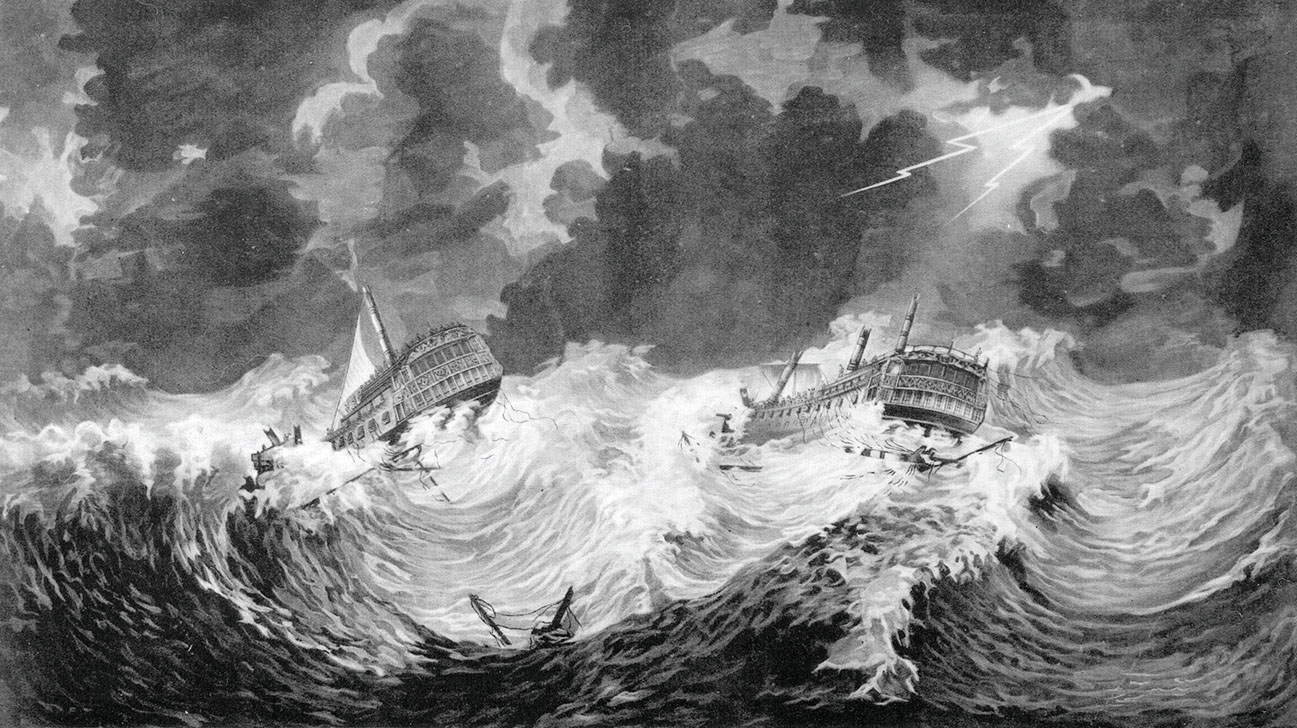
On Saturday, October 28, 1780, a dismasted Spanish schooner limped into Mobile Bay and worked her way up to town. White-coated soldiers watched from Fuerte Carlota’s battered walls, and curious residents lined the muddy river bank as she anchored opposite the King’s Wharf. The vessel had obviously been through an ordeal — stained, jury-rigged sails hung from her broken masts; fallen blocks, smashed gear and other wreckage littered her deck; and her small crew looked exhausted and hugely relieved to be alive. But only when her captain came ashore did Mobile’s governor, José de Ezpeleta, fully learn what happened.
She was the Jesús Nazareno commanded by Diego Valladares, part of a large invasion fleet that had left Havana on October 16 bound for Pensacola, the capital of British West Florida. According to Valladares, the weather was fair with a light wind when they set sail, but two days later, a terrific hurricane barreled into them. For 80 hellish hours his schooner fought wind and wave, the crew forced to throw all her cargo — provisions for the invading soldiers — over the sides to lighten the vessel.
Almost before Ezpeleta and Mobile’s shocked soldiers and residents could absorb this stunning news, another distressed ship hove into view. She was the San Josef y la Animas, loaded with hundreds of barrels of gunpowder, all waterlogged and ruined. During the coming weeks, four more damaged vessels followed, carrying weapons, entrenching tools and traumatized soldiers. Mobile’s residents knew about the planned invasion, of course, and they expected to support it once the fleet arrived, but with six damaged vessels now crowding local waters and the other ships’ fates unknown, they feared for their King’s elaborate plans.
The 1780 hurricane season was already one of the worst on record when Spanish General Don Bernardo de Galvéz announced his intention to sail that October. Pensacola was the last remaining British post on the northern Gulf rim, and Galvéz was eager to add it to his growing list of conquests. None but a fool doubted his ability to do so. When Spain allied with France in 1779 and threw its weight against Britain in the widening American Revolution, Galvéz had surprised everyone by rapidly expelling the redcoats from the lower Mississippi River and Mobile. Pensacola’s nervous holdouts could only strengthen their fortifications and await the hammer blow.
By mid-October the formidable Spanish fleet was amassed and ready in Havana harbor. It included seven ships of the line, six frigates, two hospital ships, and over 50 transports loaded with supplies, provisions and 4,000 crack troops. The overall naval commander was José Solano y Bote, a gifted 54-year-old officer blessed with a cooperative nature. Nonetheless, as Galvéz quickly learned, Solano wasn’t about to rashly endanger his vessels to meet the army’s timetables. The so-called Great Hurricane of 1780 that lashed the Caribbean, killed thousands, and wrecked both British and French ships had barely dissipated when Galvéz wanted to sail. Solano counseled caution, gathered his captains and carefully assessed the weather. They all agreed it was safe, provided the wind did not veer overnight.

So it was that on October 16, with signs favorable, the fleet sailed north. Solano carefully recorded the momentous events that followed in his diary. Only one day out he ominously wrote, “The wind freshened at NE, scud and heavy clouds closing in upon us.” Alas for the Spaniards, yet another hurricane had churned out of the Caribbean, roared over western Cuba and into the Gulf, where it caught the fleet near the Dry Tortugas Islands, 70 miles west of Key West. “By 9 at night,” Solano continued, “the wind increased, and was then at NE 1/4 E, with torrents of rain and some hard squalls.” Worse was to come. Daybreak on the 18th brought “heavy clouds, rain, wind and sea. Two ships and a brig of the convoy in sight.”
Every vessel was on her own, the crews blinded by lashing rains and heaving waves. Solano briefly sighted another ship that signaled she was “leaky” before a curtain of rain obscured her again. Solano ordered his men to close-reef (reduce) their sails, so the flagship could better ride the storm. Two horrific days later she was still “sustaining heavy and repeated squalls.” By October 21, a driving head sea broke over the bow, sluiced down the deck and snapped her masts. The crew scrambled to hack away the wreckage lest trailing masts and spars slue the vessel abreast of the waves, causing her to capsize.
Amid the chaos, Solano’s brave sailors managed to improvise smaller sails on the shattered masts — just as the crews of the Jesús Nazareno and San Josef y la Animas would do — and the flagship remained afloat. At last, on October 22, the wind abated, and lookouts spotted other ships, some heavily damaged, others still seaworthy. Continuing the invasion was out of the question. Vessels were scattered from the northern littoral to the Yucatán, several had sunk and hundreds of men drowned. Solano ordered the ships he sighted to return to Havana. Others made whatever port they could reach: New Orleans, Veracruz, Campeche or Mobile.
Back in Havana, the cautious War Council wanted to cancel any further attack plans. But the indomitable Galvéz urged them to repair the fleet and strike again. “Have we so little constancy that a single tropical storm suffices to halt us?” he asked incredulously. Thanks to his perseverance, Solano’s cooperation, and the hard work of thousands, the fleet sailed again the following spring and successfully landed the army. Pensacola fell after a monthslong siege. Among the support vessels were the Jesús Nazareno, the San Josef y la Animas and the four other ships that had found refuge in Mobile Bay.
John S. Sledge is the author of “The Gulf of Mexico: A Maritime History.”





